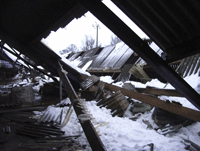Protecting buildings from snow damage

Finding a way to prevent farm buildings from collapsing from the weight of snow will be one of the main topics at this year’s Agricultural Buildings Event at Stoneleigh Park, Warwickshire on 29 March.
The heavy snowfalls of late 2009 and late 2010 each prompted the collapse of several thousand farm buildings.
“Some failed because they were old, others because of the volume of snow,” says Geoff Simpson, vice-chairman of the farm building industry body, the Rural and Industrial Design and Building Association (RIDBA).
A few buildings, however, failed because they were structurally inadequate and that included new buildings, he says. In fact, one building collapsed before the first animal had even set foot in it.
Mr Simpson will be outlining the problem and looking at possible remedies at a seminar at this year’s ABS event.
With global warming expected to increase the number of occurrences of extreme weather, the likelihood is that heavy snowfalls could become more common. That means farmers may need to be prepared to spend more on new buildings to ensure they can withstand heavier snow-loadings. It also puts many existing buildings in danger of damage or collapse.
The total weight of snow on a big roof can be frighteningly high. Dry snow 1m deep on a barn roof typically puts an extra loading of 30kg on every square metre of the roof, which isn’t too catastrophic. But wet snow of the same depth can be up to 10 times heavier, putting a massive 300kg of extra loading on every square metre of the roof.
A more likely scenario (and one that happened last winter) is 60cm of snow that is mid-way between dry and wet. That still gives a loading of 130kg a square metre, which over a 30m x 20m roof means an extra weight of 78t – equivalent to two fully loaded grain lorries.
• For more details on this year’s Agricultural Buildings Event, go to www.farm-smart.co.uk

